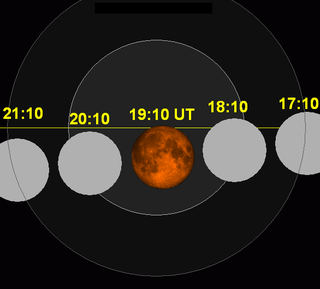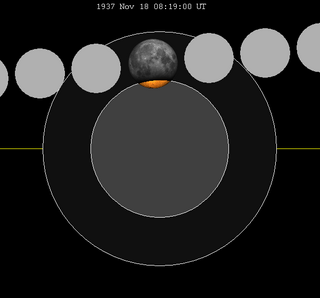
A total lunar eclipse took place on 4 April 2015. It is the former of two total lunar eclipses in 2015, and the third in a tetrad. Other eclipses in the tetrad are those of 15 April 2014, 8 October 2014, and 28 September 2015.

A total lunar eclipse took place between 27 and 28 September 2015. It was seen on Sunday evening, 27 September, in the Americas; while in Europe, Africa, and the Middle East, it was seen in the early hours of Monday morning, 28 September. It was the latter of two total lunar eclipses in 2015, and the final in a tetrad. Other eclipses in the tetrad are those of 15 April 2014, 8 October 2014, and 4 April 2015.

A total lunar eclipse occurred on 15–16 May 2022, the first of two total lunar eclipses in 2022. The event occurred near lunar perigee; as a result, this event was referred to some in media coverage as a "super flower blood moon" and elsewhere as a "super blood moon", a supermoon that coincides with a total lunar eclipse. This was the longest total lunar eclipse visible from nearly all of North America since August 17, 1989 until the next eclipse on November 8.

A total lunar eclipse will take place on November 18, 2040. The southern limb of the Moon will pass through the center of the Earth's shadow.

A total lunar eclipse will take place on October 19, 2051. The northern limb of the Moon will pass through the center of the Earth's shadow.

A total lunar eclipse took place on Thursday, December 30, 1982. A shallow total eclipse saw the Moon in relative darkness for 1 hour 3 seconds. The Moon was 18% of its diameter into the Earth's umbral shadow, and should have been significantly darkened. The partial eclipse lasted for 3 hours and 16 minutes in total. This was a supermoon since perigee was on the same day. It was also a blue moon, the second full moon of December for the eastern hemisphere where the previous full moon was on December 1. Since total lunar eclipses are also known as blood moons, this combination is known as a super blue blood moon.

A partial lunar eclipse took place on Saturday, December 21, 1991, the last of four lunar eclipses in 1991. The moon grazed the northern edge of the umbral shadow. It occurred near perigee, and as described, such event was known as a supermoon.

A total lunar eclipse occurred on 31 January 2018. The Moon was near its perigee on 30 January and as such may be described as a "supermoon", when the Moon's distance from the Earth is less than 360,000 km. The previous supermoon lunar eclipse was in September 2015.

A partial lunar eclipse will take place on Wednesday, January 12, 2028.

A total lunar eclipse will take place on Thursday, April 14, 2033.

A total lunar eclipse will take place on Saturday, January 31, 2037. The Moon will be plunged into darkness for 1 hour and 3 minutes 41 seconds, in a moderately deep total eclipse which will see the Moon 20.74% of its diameter inside the Earth's umbral shadow. The visual effect of this depends on the state of the Earth's atmosphere, but the Moon may be stained a deep red colour for observers in north and west North America, most of Asia, Australia and New Zealand. The partial eclipse will last for 3 hours and 17 minutes 28 seconds in total. It occurs during a supermoon (perigee), and blue moon, just like the eclipse of January 31, 2018, one metonic cycle previous.

A total lunar eclipse took place on Monday, May 13, 1957, the third of fourteen total lunar eclipses of Lunar Saros 130. The Moon was plunged into darkness for 1 hour and 18 minutes, in a deep total eclipse which saw the Moon 30% of its diameter inside the Earth's umbral shadow. The visual effect of this depends on the state of the Earth's atmosphere, but the Moon may have been stained a deep red colour. The partial eclipse lasted for 3 hours and 32 minutes in total.

A penumbral lunar eclipse will take place on October 28, 2042, according to some sources. This will be 0.4 days after the Moon reached perigee. This event marks the beginning of lunar saros cycle 156 according to some sources, and will be visually imperceptible and other sources have this as a miss.

A partial lunar eclipse took place on Monday, December 10, 1973, the last of four lunar eclipses in 1973, the first was a penumbral lunar eclipse on January 18, the second was a penumbral lunar eclipse on June 15, and the third was a penumbral lunar eclipse on July 15. It occurred near perigee, and as described, such event was known as a supermoon.

A partial lunar eclipse took place on Tuesday, November 29, 1955 with an umbral eclipse magnitude of 0.11899. A partial lunar eclipse happens when the Earth moves between the Sun and the Full Moon, but they are not precisely aligned. Only part of the Moon's visible surface moves into the dark part of the Earth's shadow. A partial lunar eclipse occurs when the Earth moves between the Sun and Moon but the three celestial bodies do not form a straight line in space. When that happens, a small part of the Moon's surface is covered by the darkest, central part of the Earth's shadow, called the umbra. The rest of the Moon is covered by the outer part of the Earth's shadow called the penumbra. It was the second of two lunar eclipses in 1955, first being the penumbral lunar eclipse on June 5. It also occurred near perigee, making such event a supermoon.
A partial lunar eclipse took place on Tuesday, August 5, 1952. The Earth's shadow on the Moon was clearly visible in this eclipse, with 53.2% of the Moon in shadow; the partial eclipse lasted for 2 hours and 27 minutes. The Moon's apparent diameter was larger and Supermoon because the eclipse occurred only 45 minutes before perigee.

A total lunar eclipse will take place on September 7, 2044. It will be the first total eclipse in Lunar Saros 138.

A total lunar eclipse will take place on March 25, 2043.

A supermoon is a full moon or a new moon that nearly coincides with perigee—the closest that the Moon comes to the Earth in its elliptic orbit—resulting in a slightly larger-than-usual apparent size of the Moon as viewed from Earth. The technical name is a perigee syzygy or a fullMoon around perigee. Because the term supermoon is astrological in origin, it has no precise astronomical definition.

A partial lunar eclipse took place on Thursday, November 18, 1937, the second of two lunar eclipses in 1937. This event took place near perigee, and as described, such event was known as a supermoon.







































